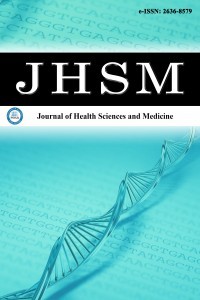Predictors for axillary lymph node metastasis in primary neuroendocrine carcinomas of the breast and neuroendocrine differentiated breast cancers
Predictors for axillary lymph node metastasis in primary neuroendocrine carcinomas of the breast and neuroendocrine differentiated breast cancers
___
- Kayadibi Y, Erginoz E, Cavus GH, Kurt SA, Ozturk T, Velidedeoglu M. Primary neuroendocrine carcinomas of the breast and neuroendocrine differentiated breast cancers: relationship between histopathological and radiological features. Eur J Radiol. 2022;147:110148. doi:10.1016/j.ejrad.2021.110148
- Trevisi E, La Salvia A, Daniele L, et al. Neuroendocrine breast carcinoma: a rare but challenging entity. Med Oncol. 2020;37(8):70. doi:10.1007/s12032-020-01396-4
- Bussolati G, Badve S. Carcinomas with neuroendocrine features. WHO Classification of Tumours of the Breast. 2012;4:62-3.
- Tan PH, Ellis I, Allison K, et al. The 2019 World Health Organization classification of tumours of the breast. Histopathology. 2020;77(2):181-185. doi:10.1111/his.14091
- Hacking SM, Yakirevich E, Wang Y. Defining triple-negative breast cancer with neuroendocrine differentiation (TNBC-NED). J Pathol Clin Res. 2023;9(4):313-321. doi:10.1002/cjp2.318
- Gradishar WJ, Moran MS, Abraham J, et al. NCCN Guidelines® Insights: Breast Cancer, Version 4.2023. J Natl Compr Canc Netw. 2023;21(6):594-608. doi:10.6004/jnccn.2023.0031
- Lakhani SR, Ellis IO, Schnitt S, Tan PH, van de Vijver M. WHO Classification of Tumours of the Breast. WHO; 2012.
- Rosen LE, Gattuso P. Neuroendocrine tumors of the breast. Arch Pathol Lab Med. 2017;141(11):1577-1581. doi:10.5858/arpa.2016-0364-RS
- Wang J, Wei B, Albarracin CT, Hu J, Abraham SC, Wu Y. Invasive neuroendocrine carcinoma of the breast: a population-based study from the surveillance, epidemiology and end results (SEER) database. BMC Cancer. 2014;14:147. doi:10.1186/1471-2407-14-147
- Krawczyk N, Röwer R, Anlauf M, et al. Invasive breast carcinoma with neuroendocrine differentiation: a single-center analysis of clinical features and prognosis. Geburtshilfe Frauenheilkd. 2022;82(1):68-84. doi:10.1055/a-1557-1280
- Makretsov N, Gilks CB, Coldman AJ, Hayes M, Huntsman D. Tissue microarray analysis of neuroendocrine differentiation and its prognostic significance in breast cancer. Hum Pathol. 2003;34(10):1001-1008. doi:10.1053/s0046-8177(03)00411-8
- van Krimpen C, Elferink A, Broodman CA, Hop WC, Pronk A, Menke M. The prognostic influence of neuroendocrine differentiation in breast cancer: results of a long-term follow-up study. Breast. 2004;13(4):329-333. doi:10.1016/j.breast.2003.11.008
- Siegel RL, Miller KD, Jemal A. Cancer statistics, 2017. CA Cancer J Clin. 2017;67(1):7-30. doi:10.3322/caac.21387
- Pan H, Gray R, Braybrooke J, et al. 20-year risks of breast-cancer recurrence after stopping endocrine therapy at 5 years. N Engl J Med. 2017;377(19):1836-1846. doi:10.1056/NEJMoa1701830
- Lux MP, Schneeweiss A, Hartkopf AD, et al. Update breast cancer 2020 part 5-moving therapies from advanced to early breast cancer patients. Geburtshilfe Frauenheilkd. 2021;81(4):469-480. doi:10.1055/a-1397-7170
- Lavigne M, Menet E, Tille JC, et al. Comprehensive clinical and molecular analyses of neuroendocrine carcinomas of the breast. Mod Pathol. 2018;31(1):68-82. doi:10.1038/modpathol.2017.107
- Wei B, Ding T, Xing Y, et al. Invasive neuroendocrine carcinoma of the breast: a distinctive subtype of aggressive mammary carcinoma. Cancer. 2010;116(19):4463-4473. doi:10.1002/cncr.25352
- Rovera F, Lavazza M, La Rosa S, et al. Neuroendocrine breast cancer: retrospective analysis of 96 patients and review of literature. Int J Surg. 2013;11(S1):79-83. doi:10.1016/s1743-9191(13)60023-0
- Zhang Y, Chen Z, Bao Y, et al. Invasive neuroendocrine carcinoma of the breast: a prognostic research of 107 Chinese patients. Neoplasma. 2013;60(2):215-222. doi:10.4149/neo_2013_029
- Cloyd JM, Yang RL, Allison KH, Norton JA, Hernandez-Boussard T, Wapnir IL. Impact of histological subtype on long-term outcomes of neuroendocrine carcinoma of the breast. Breast Cancer Res Treat. ı2014;148(3):637-644. doi:10.1007/s10549-014-3207-0
- Kwon SY, Bae YK, Gu MJ, et al. Neuroendocrine differentiation correlates with hormone receptor expression and decreased survival in patients with invasive breast carcinoma. Histopathology. 2014;64(5):647-659. doi:10.1111/his.12306
- Park YM, Wu Y, Wei W, Yang WT. Primary neuroendocrine carcinoma of the breast: clinical, imaging, and histologic features. AJR Am J Roentgenol. 2014;203(2):221-230. doi:10.2214/ajr.13.10749
- Bogina G, Munari E, Brunelli M, et al. Neuroendocrine differentiation in breast carcinoma: clinicopathological features and outcome. Histopathology. 2016;68(3):422-432. doi:10.1111/his.12766
- Roininen N, Takala S, Haapasaari KM, et al. Primary neuroendocrine breast carcinomas are associated with poor local control despite favourable biological profile: a retrospective clinical study. BMC Cancer. 2017;17(1):72. doi:10.1186/s12885-017-3056-4
- Metovic J, Cascardi E, Uccella S, et al. Neuroendocrine neoplasms of the breast: diagnostic agreement and impact on outcome. Virchows Archiv. 2022;481(6):839-846. doi:10.1007/s00428-022-03426-0
- Yang L, Lin H, Shen Y, et al. Clinical outcome and therapeutic impact on neuroendocrine neoplasms of the breast: a national cancer database study. Breast Cancer Res Treat. 2023;doi:10.1007/s10549-023-07052-5
- Howlader N, NA KM, Miller D, et al. SEER Cancer Statistics Review, 1975-2016. National Cancer Institute; 2019.
- Sawaki M, Yokoi K, Nagasaka T, et al. Prognostic importance of neuroendocrine differentiation in Japanese breast cancer patients. Surg Today. 2010;40(9):831-835. doi:10.1007/s00595-009-4179-2
- Zhu X, Chen L, Huang B, et al. The prognostic and predictive potential of Ki-67 in triple-negative breast cancer. Sci Rep. 2020;10(1):225. doi:10.1038/s41598-019-57094-3
- Eble JN, Tavassoli FA, Devilee P. Pathology and genetics of tumours of the breast and female genital organs. IARC; 2003.
- Yayın Aralığı: Yılda 6 Sayı
- Başlangıç: 2018
- Yayıncı: MediHealth Academy Yayıncılık
Emre DESTEGÜL, Burçak ÇAKIR PEKÖZ, Sevtap SEYFETTİNOĞLU, Sevda BAŞ, Fikriye Işıl ADIGÜZEL, Mehmet NARİN
The effect of COVID-19 vaccines on thyroid function and thyroid autoimmunity
Işılay TAŞKALDIRAN, Feride Pınar ALTAY, Yusuf BOZKUŞ, Özlem TURHAN İYİDİR, Asli NAR, Nilüfer BAYRAKTAR, Neslihan BAŞÇIL TÜTÜNCÜ
Mesut BAKIR, Şebnem RUMELİ, Mehmet Rıdvan YALIN, Fatma ÇELİK
Quality, reliability, and content assessment of YouTube™ videos associated with aphasia
İbrahim Can YAŞA, Gözde MALKOÇ
Histopathological evaluation of the effects of sildenafil on organ damage in a diabetic rat model
Mehmet KARA, Halit BAYKAN, Esra ÖNAL, Ayşegül Burçin YILDIRIM, Derya KARABULUT
Ömer TAŞARGÖL, Halil Cihan KÖSE
Evaluation of the readability of consent forms used in cardiovascular surgery clinics
